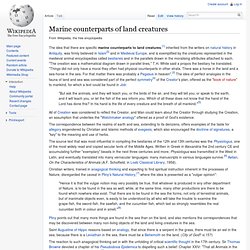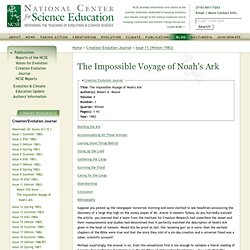

Marine counterparts of land creatures. The idea that there are specific marine counterparts to land creatures,[1] inherited from the writers on natural history in Antiquity, was firmly believed in Islam[2] and in Medieval Europe, and is exemplified by the creatures represented in the medieval animal encyclopedias called bestiaries and in the parallels drawn in the moralising attributes attached to each.

"The creation was a mathematical diagram drawn in parallel lines," T.H. White said a propos the bestiary he translated. "Things did not only have a moral they often had physical counterparts in other strata. There was a horse in the land and a sea-horse in the sea. For that matter there was probably a Pegasus in heaven".[3] The idea of perfect analogies in the fauna of land and sea was considered part of the perfect symmetry[4] of the Creator's plan, offered as the "book of nature" to mankind, for which a text could be found in Job: "There are in the Sea, Fish of almost all the Figures of Land-Animals, and even of Birds.
Catlin Seaview Survey. Solvin Zankl photography. Gallery. Plankton Chronicles. TalkOrigins Archive: Exploring the Creation/Evolution Controversy. Life Before the Dinosaurs. The Impossible Voyage of Noah's Ark. Building the Ark Accommodating All Those Animals Leaving Some Things Behind Sizing Up the Load Gathering the Cargo Surviving the Flood Caring for the Cargo Disembarking Conclusion Bibliography Suppose you picked up the newspaper tomorrow morning and were startled to see headlines announcing the discovery of a large ship high on the snowy slopes of Mt.

Perhaps surprisingly, the answer is no. Building the Ark The requirements of the story. To make this point clear, let's start at the beginning of the biblical narrative and follow the story step by step. The ark is to be made out of gopher wood according to a plan that calls for the ark to be three hundred cubits long, fifty cubits wide, and thirty cubits tall (450x75x45 feet, according to most creationists. . - page 2 - Ancient shipbuilding. In the first place, the analogy with the Seven Wonders does not hold. . - page 3 - Not only was the ark without pedigree, it was without descendants also.
The needs of the animals. Problems for the builders. - page 4 - The World's Most Unanswered Science Questions. Roko's basilisk. Roko's basilisk is a thought experiment about the potential risks involved in developing artificial intelligence.

The experiment's premise is that an all-powerful artificial intelligence from the future could retroactively punish those who did not help bring about its existence; even those who merely knew about the possibility of such a being coming into existence incur the risk of punishment. It resembles a futurist version of Pascal's wager, in that it suggests people should weigh possible punishment versus reward and as a result accept particular singularitarian ideas or donate money to support their development.
It is named after the member of the rationalist community LessWrong who described it, though he did not originate the underlying ideas. [edit] Summary [edit] The Basilisk Roko's Basilisk rests on a stack of several other propositions, generally of dubious robustness. Why would it do this? [edit] He also called removing Roko's post "a huge mistake". [edit] Background [edit] Xkcd what if. Phenomena: Not Exactly Rocket Science. Scientific Illustration: Archive. BioDivLibrary's photosets on Flickr. The Echinoblog. Jakapi.